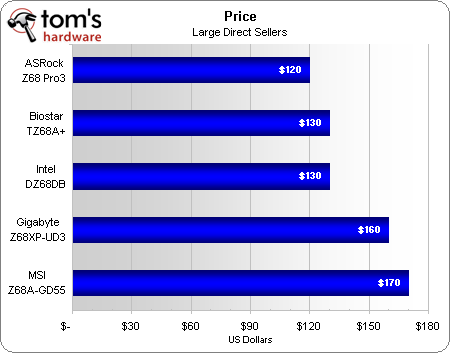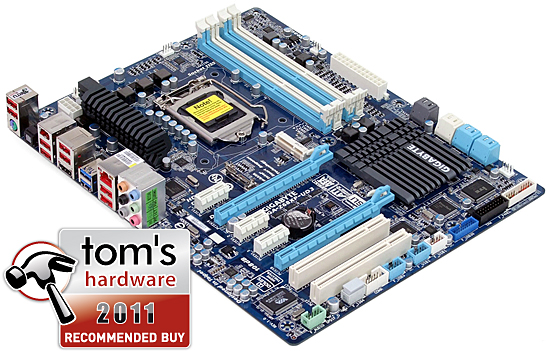From $100 To $160: Five Z68-Based Boards, Compared
Value-oriented system builders celebrate new-found performance and features as Intel continues pushing its mainstream platform towards the high-end. Today, we draw a line in the sand and consider five motherboards priced between $100 and $160.
Value Conclusion
Before we can assess value, let’s take a quick look at what today’s value-oriented performance motherboards currently cost:
ASRock deserves applause for including Lucidlogix's Virtu license on a motherboard priced at only $120. Yet, for a few dollars more, one could buy Biostar’s superb overclocker. Both of these boards come up a little short on even the most basic features though, and for that we can look to Intel’s DZ68DB. Buyers can break that tie on their own based on overclocking ambitions and connectivity needs.
That brings us to the Gigabyte versus MSI debate. A few days ago it seemed as though MSI's only issue was hitting ample volume with its board to push prices down to where our story required. We were ready to hand Gigabyte the value victory when MSI's Z68A-GD55 showed up on Newegg for the same $170 we'd seen elsewhere. But MSI pulled a rabbit out of its hat with a $20 mail-in-rebate.
A slight edge in overclocking could make MSI's $150 after-MIR price a better value to some buyers, though it also comes up around $10 shorter in features. At the end of the day, the fact that you have to send away to get $20 back (and we all know how many folks actually take that step) gives Gigabyte the narrow advantage here.
The problem is that all five of today’s products deserve an award: ASRock based on price alone, Biostar based on overclocking alone, Gigabyte based on features alone, Intel based on its combination of price and connectivity, and MSI based on its combination of features and overclocking. Handing out five awards to five vendors diminishes the value of giving the things out in the first place. But we can tell you which one we’d pick for any number of tasks.
Our kid brother gets the Z68 Pro3 because it’s cheap. He doesn’t need a bunch of features, and we don’t want to waste money on stuff he won’t use.
Our significant others get the DZ68DB because they have so many portable devices and peripherals. They don’t care what’s under the hood, and they won’t overclock.
Get Tom's Hardware's best news and in-depth reviews, straight to your inbox.
The tech-curious kid next door gets the TZ68A+ because he’s done such a great job of mowing the lawn. He’ll spend hours overclocking it to perfection, and it’s still cheap enough to give away.
For Tom’s Hardware editors, the choice is less clear. A few of us use FireWire on occasion, but not often enough to make it a primary consideration in motherboard selection. The Z68XP-UD3 also adds a PCIe 2.0 x1-based SATA controller, but few of us use more than six drives in our personal PCs. But we’d hate to pay even more to not get those features with MSI, even though the Z68A-GD55 is marginally more efficient and an insignificantly better overclocker.
After careful deliberation, Gigabyte’s Z68XP-UD3 gets our Recommended Buy award.
-
compton I temporarily used a Biostar TH67+ 1155 mobo until I picked up my new board. After seeing the description of the Z chipset's Graphical UEFI I checked Biostar's website. It looks as though they're released the graphical UEFI for all biostar 1155 mobos.Reply
Now I just wish Intel would do the same -- can't they just rip off Asus's UEFI implementation? -
johnnyb_27 Why not use the MSI's Z68A-G65 instead of the MSI's Z68A-G55? They were the same price but now the drop MSI's Z68A-GD55 to 154 before rebate.Reply -
hatethisbull 90% of this article could've been compressed into the summary page. I would've preferred to see comparisons between, say, a $70 h67 and a high-end z68. Instead of four pages of unsatisfying gaming benchmarks, how about focusing on board usability? Which of the boards have cheap PCI-E retention clips that are going to pop off on first use? Which ones will have blocked ports, etc.Reply -
The Greater Good vilenjanWhat about looks? The gigabyte board looks so meh, while the MSI board is sexy!Reply
Do you stare into your case whilst computing, or do you look at the monitor? -
aznguy0028 The Greater GoodDo you stare into your case whilst computing, or do you look at the monitor?I look into my case daily when I use the computer. There's a reason why there is a window, and hours of hard work for your perfect wiring job deserves much credit and to be stared at. Not to mention coloring schemes that matches your case/mobo pcb color/fan led colors/etc.Reply -
Crashman johnnyb_27Why not use the MSI's Z68A-G65 instead of the MSI's Z68A-G55? They were the same price but now the drop MSI's Z68A-GD55 to 154 before rebate.MSI picked the GD55 because it's SUPPOSED to cost $160. MSI did NOT pick the GD65 because it's SUPPOSED to cost $180. MSI's predictions from a few weeks back simply didn't pan out.Reply -
Crashman jerreddreddisn't it time we lost the PS2 port? and maybe even the DB15 VGA port also?Not PS/2, just VGA. They leave the Multi-I/O controller on the board for compatibility in other areas, so PS/2 is "free" and some people still use it at the high end.Reply
Some cheap monitors still use VGA, but these boards are not for the budget market! For VGA compatibility (for external capture devices and such) they could just use DVI-I and let the oddball user who needs VGA for that oddball purpose supply his own adapter.


